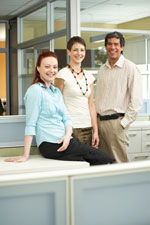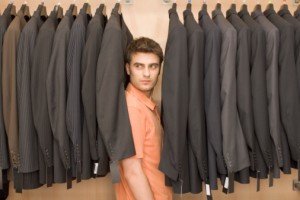 Like it or not first impressions carry some weight in your hunt for a new job. Whether you are heading to a job fair, attending a networking event, or going to a job interview you’ll want to make sure your first impression sends the right message.
Like it or not first impressions carry some weight in your hunt for a new job. Whether you are heading to a job fair, attending a networking event, or going to a job interview you’ll want to make sure your first impression sends the right message.
1. Keep it simple.
When you’re networking or presenting work samples during an interview, chances are you’ll have a few belongings with you. While this is understandable, you don’t want to make it a nuisance. For example, if you’re at an association meeting make sure to have business cards in your shirt pocket or the outer pocket of a purse. You don’t want to have to dig through a backpack for them. In addition, try not to carry around a portfolio and a drink at a meeting, you won’t be able to shake hands or accept any handouts without awkwardly setting your other items down. Choose a simple glass or bottle of water at an interview over a cup of coffee that requires milk, cream, etc., it will help you stay focused on the meeting. Before you head out the door, take inventory of your belongings and see if you can leave anything behind that would reduce your personal clutter – remember less is more.
2. Check your scent.
Whether it’s heavy perfume or clothing scented with your favorite Thai restaurant, it’s best to be seen and not smelled. People can be sensitive to smells, and you wouldn’t want an interviewer distracted by your heavy cologne. Reduce scents by avoiding strong perfumes and scented lotions. Don’t eat at aromatic restaurants prior to meetings and make sure to combat bad breath after meals with mints or by brushing your teeth.
3. Match and mirror.
Take note of the mood and environment of any event and match your responses appropriately. You may typically be fairly informal in conversations, but if you’re being introduced as “Mr. Smith,” make sure to address others using their surname. If you’re at a company meal and no one orders an alcoholic drink, mirror their response and save your cocktail for another night. First impressions aren’t a time to make bold impressions. If your interviewer voices a strong opinion on upcoming legislation, it’s okay to share your understanding of the changes but avoid debating the issue at a first meeting. While it’s important to connect with others, it’s best to play it safe.
4. Step out.
The shoes make the man, right? Well not quite, but having clean and appropriate footwear does help set the right first impression. It’s not the time to break out your killer heels. Make sure your work boots have been cleaned from excessive dirt and repaired of any wear and tear. You don’t have to have new or expensive shoes, but consider taking your dress shoes for a professional shoe polish. You’ll be amazed what a difference this can make. Of course you can polish them yourself, but you need to do this sooner rather than later. When you’re heading to an interview, the last thing you want is to be late because you are cleaning your shoes.
5. Hats off.
Leave your baseball cap at home when you’re heading out to meet new people. Hats can make it hard for people to see your eyes, making conversation awkward. Also, fix your hair and avoid outrageous styles for first impressions. You don’t want people to remember your hair style, you want to be remembered for your thoughtful insights and engaging attitude. At the same time, make sure your hair is styled. Throwing it up in a ponytail may work for casual Friday, but when you want to look your best, put a little effort into fixing your hair.
While it may not be fair to judge a book by its cover, when it comes to first impressions, the best rule is to not do anything too extreme. While a conversational piece of jewelry is okay, wearing a tiara to stand out is taking it too far. Bringing a portfolio to show off your work samples is fine, requesting an easel for a flip chart and overhead projector for your PowerPoint is overboard. The less you have to handle, the more you can focus on connecting with your new contacts.
By Rachel Rudisill



